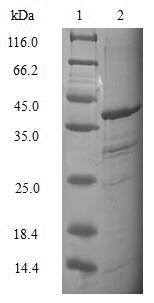Thanks for your inquiry. As to your question about the complex protein VCB (VHL complex with Elongin B protein), sorry, we can't provide the complex protein,but we can provide the monomer protein separately. Probably you can purchase these monomer proteins and make the complex protein by yourself.
Please check information as follows:
Elongin B:
Reference:http://www.uniprot.org/uniprot/Q15370
Recombinant Human Transcription elongation factor B polypeptide 2(TCEB2)
CSB-EP620878HU >> E.coli
Expression region: 1-118aa; Full length.
Tag information:N-terminal GST-tagged.
Sequence:
MDVFLMIRRHKTTIFTDAKESSTVFELKRIVEGILKRPPDEQRLYKDDQLLDDGKTLGECGFTSQTARPQAPATVGLAFRADDTFEALCIEPFSSPPELPDVMKPQDSGSSANEQAVQ






